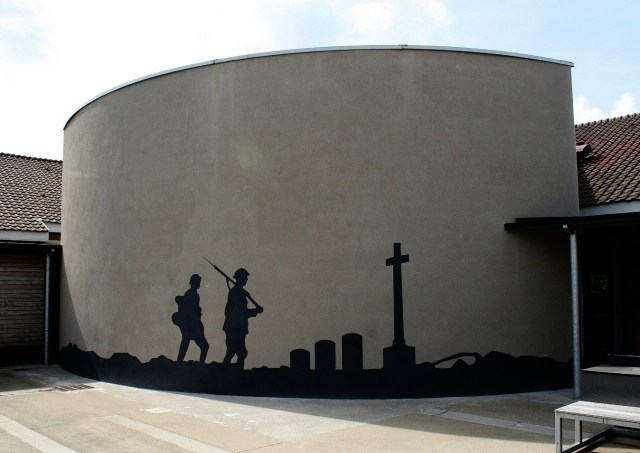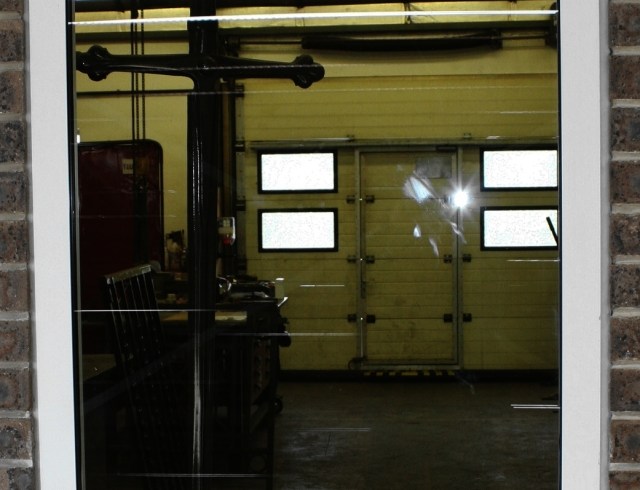A quick trip back to Arras for an even quicker look at the home of the CWGC.
Racks of brand new headstones,…
…most yet to be inscribed,…
…a few already awaiting transportation to who knows where.
Well, actually, we do.
The two headstones nearest the camera here are going to Nairobi, in Kenya (Private Yonatas Karinga of the East African Military Labour Corps died on 2nd August 1943 and is buried in Nairobi War Cemetery) and to Malta, ‘cos it says so on their bases. The Malta headstone, and the one behind it, are both for civilian casualties – you can see the small notches at the top of both headstones (and on the right below). Those on the left…
…are destined for the Middle East. The headstone in the left foreground is bound for Khayat Beach War Cemetery in Haifa* in Israel, the next four to Egypt, one a replacement headstone for an El Alamein casualty. The stack in the left background appears bound for India. The headstone destined for Khayat Beach…
*I once spent a night Sleepless in Haifa, and it was no romantic comedy.
…can be seen by its shape to be for a member of the Polish Forces (who died in August 1943), and the one in the foreground is for Constable Peter Shaughnesey of the Palestinian Police, who was accidentally shot & killed on 7th July 1946, aged 21. I presume that his original headstone was identical to the new one, but how come it takes me five minutes to find his first name and age, which surely could have been put on his new headstone? He is actually buried in Haifa (Sharon) British Civil Cemetery, which is a small section of seventy three graves, nearly all of whom are Palestinian Police casualties (and therefore British*), within Khayat Beach War Cemetery, which has 764 casualties of its own from numerous different nations.
*the Palestine Police Force was a British colonial police service established in Palestine on 1st July 1920.
I cannot give you a complete tour of the complex,…
…so I have mainly concentrated on the exhibits that cover headstones, such as this one (above & below). Click the pics to enlarge.
Well?
And this one, which shows the standard CWGC headstone and its dimensions, as well as revealing how much of the headstone actually ends up underground.
Various headstone designs, and although the text says there are over thirty, here we have just sixteen – why not show them all?
Samples of the different stones used in the manufacture of headstones (from left): Botticino Marble, Hopton Wood (Stone), Portland Stone, Rustenburg Granite, Cove Red Sandstone & Slate.
Headstone badges,…
…and cemetery paraphernalia (above & below).
Nice new cemetery register box…
…bronze longsword of the type you find on every Cross of Sacrifice,…
…and other items, snapped through the windows of one of the workshops.
‘Historically we used smaller coffins to rebury partial remains. However, nowadays member governments provide full-size coffins for all casualties.’
Selection of CWGC cemetery signs. Amazing how they all point the same way……
























I may have told this story here long ago, but around a decade ago I was working for a Canadian Member of Parliament. A man who’d heard of my interests in military history came into the office with a photo album with pictures he and his wife had recently taken at the Moro River Canadian War Cemetery at Ortona Italy. His brother had been killed in action in the furious battles in Ortona in the week surrounding Christmas 1943. I noticed that his brother’s headstone had a crack in it that started at the top middle, and proceeded own about 8 inches into the marker. At closing time I found an email contact for the director of the Central Region of the CWGC in Rome. I sent an email and provided the details. I was astounded when I had a reply at opening the next morning, saying that he’d sent an engineer out to inspect the stone. One week later I got a second email saying the headstone had been replaced. That’s a testament to the professionalism, and dedication of the CWGC to the memory of our fallen. And, to the efficiency of the fabrication, transport system of the Headstone “Fabrik at CWGC you visited.
Was that the lady that had one of my photos – Caterpillar Crater – on her wall or desktop or somesuch? Anyway, your story very much shows how good they are. And if you did tell it before (and it doesn’t ring a bell), I reckon we are long enough down the line for a few repeats!!
It could be so, but I don’t remember it specifically. I’ll slip back to those posts around Hill 60 soon, and see if there’s a memory jarring note there.
A question if you don’t mind. How are the half dozen varieties of stone used in the headstones allocated ? By region, climate ?
Excellent post as always. Hope to get there one day.
Thank you
Worth a visit if you are in Arras anyway. You might need to arrange in advance – not sure.
I fully agree with these positive comments about the CWGC. The organisation is, in my experience, timely and helpful in responding to queries and requests for information. I found the staff in the branch at Menenstraat, Ieper some time ago to be highly knowledgeable and efficient.
Thanks again M/F for another interesting and informative post.
Cheers Gordon!